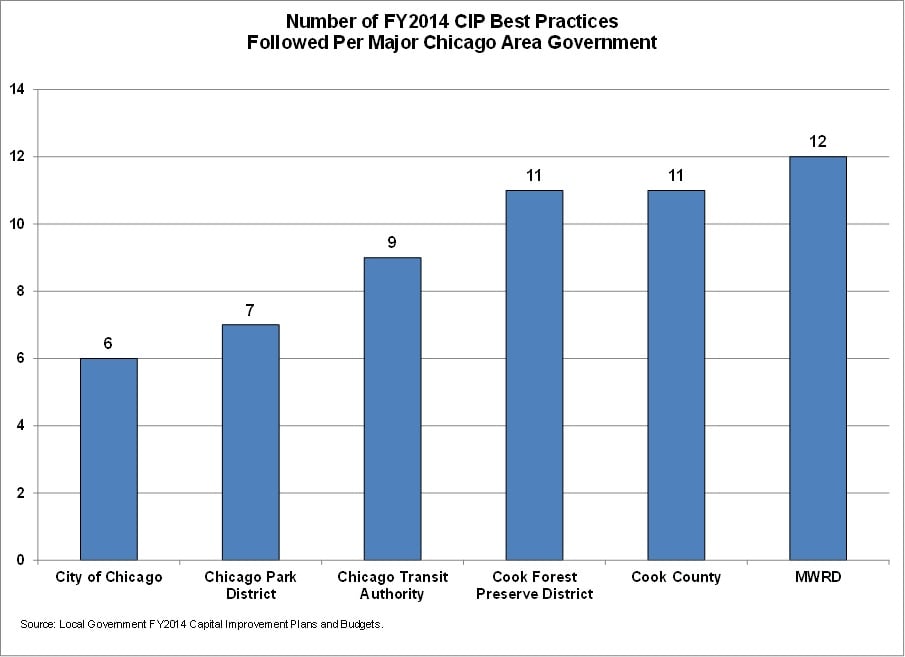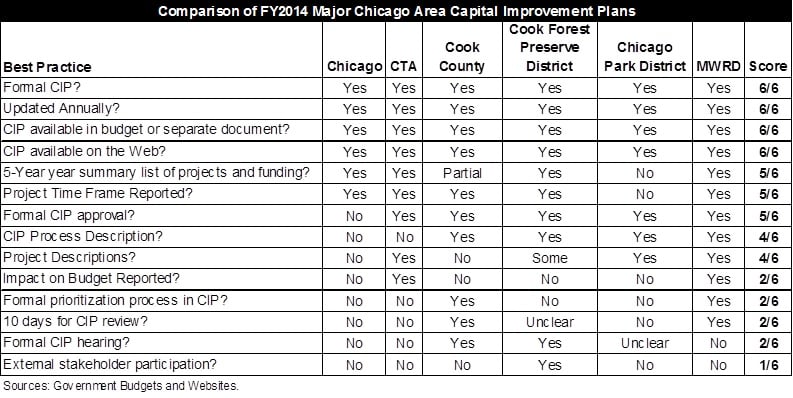January 15, 2014
As a follow-up to the Capital Planning Overview, this blog post summarizes information contained in the Civic Federation’s FY2014 budget analyses to compare how well the capital improvement plans (CIPs) of six major Chicago area governments conform to best practice guidelines. The governments are the City of Chicago, the Chicago Transit Authority (CTA), Cook County, the Cook County Forest Preserve District, the Chicago Park District and the Metropolitan Water Reclamation District (MWRD).
Definition and Purpose of Capital Improvement Plans
A capital improvement plan (CIP) is a multi-year plan that forecasts future facility, infrastructure and equipment needs as well as the appropriations earmarked to meet those needs. It also identifies financing sources and reports the impact of capital spending on the operating budget. A CIP may be forecast for a period of time ranging from three to ten years.
The primary purpose of a CIP is to establish priorities that balance capital needs with available resources, pair capital projects with funding sources, help ensure orderly repair and maintenance of capital assets and to provide an estimate of the size and timing of future debt issuances. The first year of a CIP is the capital budget for that fiscal year and ideally, it is updated annually. Developing a CIP is an important financial accountability measure because capital projects are costly and must be paid for over a number of years.
Best Practices in Capital Improvement Planning
The National Advisory Council on State and Local Budgeting (NACSLB) and the Government Finance Officers Association (GFOA) have both developed best practices in capital improvement planning.[1] In addition, the Civic Federation also has developed several recommended practices in this policy area.
Civic Federation Checklist of CIP Best Practices
The Civic Federation annually reviews the capital improvement plans of major Chicago area local governments to analyze how well they conform to key best practice principles. The review is included in the analyses of individual budgets. The fifteen items considered are grouped into three broad categories: 1) Preparation of the CIP; 2) CIP Elements; and 3) CIP Transparency and Stakeholder Participation
Preparation of the CIP
- Does the government prepare a formal capital improvement plan?
- How often is the CIP updated?
CIP Elements
- Does the capital plan include a narrative description of the CIP process?
- Does the capital plan include a five-year summary list of projects and expenditures by project as well as funding sources per project?
- Does the capital plan include information about the impact and amount of capital spending on the annual operating budget for each project?
- Does the capital plan include brief narrative descriptions of individual projects, including the purpose, need, history, and current status of each project?
- Does the capital plan include the time frame for fulfilling capital projects?
- Are projects ranked and/or selected according to a formal prioritization or needs assessment process?
CIP Transparency and Stakeholder Participation
- Is the CIP published in the budget or a separate document?
- Is the CIP available online?
- Is there stakeholder participation on a CIP advisory or priority setting committee?
- Does the governing body hold a formal public hearing at which stakeholders may testify?
- Is the public permitted at least ten working days to review the CIP prior to a public hearing?
- Is the CIP formally approved by the governing body of the government?
- Is the CIP integrated into a long term financial plan?
Comparison of Six Major Chicago Area Capital Improvement Plans
The following table shows how well each of the major Chicago area local governments scored on a 14-point checklist for their fiscal year 2014 CIPs. The question about whether the CIP was integrated in a long-term financial plan was omitted because it was unclear from reviews of respective CIPs whether any of the governments except the MWRD followed this practice.
- All six of the local governments produced a formal CIP, updated it annually, made it available in the budget or a separate stand-alone CIP and made it accessible on their website.
- Five of the six governments published a five-year summary list of projects, reported the time frame for project completion and had the CIP formally approved by the governing body (several approved the CIP as part of the budget document).
- Four governments described the CIP process and provided project descriptions.
- Only two governments – the CTA and the MWRD – provided a discussion of the impact of the CIP and capital projects on the annual operating budget.
- Two governments provided 10 days for review of the CIPs; this was because the CIP was included in the budgets and at least that amount of time was provided for public review of the budget document.
- Cook County and the MWRD included a discussion of the capital prioritization process used in their CIPs.
- Cook County and the Cook County Forest Preserve District held a hearing at which capital projects were discussed as part of the overall budget process.
- Only the Cook County Forest Preserve District provided opportunities for external stakeholder participation in the CIP process.


The next chart shows how many of the fourteen CIP best practices were followed by each of the six Chicago area governments reviewed. The MWRD had the best record, adhering to twelve of the fourteen best practices; the two practices not followed were including external stakeholders in the CIP process and holding a formal CIP hearing. Two governments, Cook County and the Forest Preserve District of Cook County, tied for second place, adhering to eleven of the best practices. The CTA followed nine best practices, while the Chicago Park District only implemented half or seven of the indicators. The City of Chicago followed the fewest number of best practices, implementing just six of the fourteen indicators.
[1] National Advisory Council on State and Local Budgeting Recommended Practice 9.10: Develop a Capital Improvement Plan, p. 34; Government Finance Officers Association, Best Practices, Development of Capital Planning Policies, October 2011


